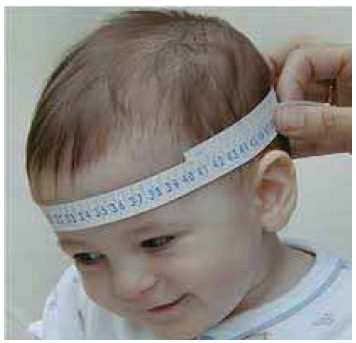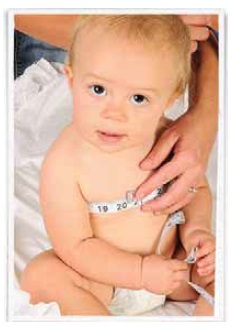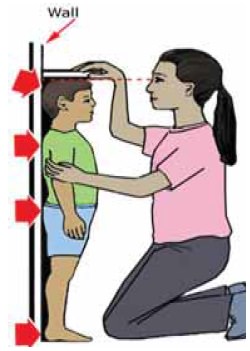Nursing - Head to foot examination | 11th Nursing : Chapter 5 : Nursing - Health Assessment and Physical Examination
Chapter: 11th Nursing : Chapter 5 : Nursing - Health Assessment and Physical Examination
Head to foot examination
Head to foot examination
Measurement of Weight
Quantitative
expression of body mass, which indicates state of growth and health, is
measured in kilograms or pounds using adult or infant weighing scale.
Checking Weight of an Infant

Purposes:
·
To check whether an infant has adequate weight for age
·
To calculate food requirements
·
To calculate intravenous fluids and medications
·
To monitor whether an infant gaining or loosing weight depending
on disease condition
Required articles
·
Infant weighing scale-infantometer
·
Draw sheet
·
Duster
·
Paper and pencil for calculation
Procedure:
1.
Clean the weighing scale with wet duster
2.
Place draw sheet on the scale
3.
Balance the scale to read zero
4.
Place the weighing scale close to the wall to prevent the child
from falling
5.
Instruct mother to stand beside the scale
6.
Undress the child before weighing
7.
Mummify the infant with the same draw sheet and place the infant
on the scale
8.
Place the left hand over the infant without touching
9.
Note the weight
10.
Lift the infant from the scale and help the mother to dress the
infant
11.
Check and compare previous weight
12. Difference of more
than 100 gms, needs to be clarified by rechecking the infants weight
immediately
13. If the difference is
still the same, it should be informed to the doctor concerned.
14. If the weight is in
pounds and it must be converted to kilograms using conversion table.
15. Document the weight
1 Kg = 2.2 lbs
Measuring the Length of an Infant

Measurement of length
by placing the child on a paper covered surface. Making the end points of the
top of head and heels of the feet, and measuring between the two given points
gives the length of the child.
Length of the baby can
be measured in weighing scale by marking with scale between head and heel
points.
Measurement of Head Circumference
1.
Place light drape or paper on flat surface
2.
Place infant in supine position or seated on paper drape
3.
Place tape measure over the most prominent point of the occiput,
around the head just above the eyebrows and pinna. This point is should be
taken as head circumference.

Measurement of Chest Circumference
Place tape measure underneath the back of baby and bring it to front measured at nipple line gives the chest circumference.

Measurement of Mid-Arm Circumference

1.
Place the tape vertically, alone the posterior aspect of the
upper arm to the acromian process and the olecranon process.
2.
Half measured is the mid point
3.
Place the inch tape at the midpoint and measure around the arm.
It gives the mid arm circumference.
Measurement of Height & Weight of Adult

Measurement of Height:
Height is a measurement from head to toe that indicates the
state of growth and health. It is measured in feet, inches or centimeters.
Purpose:
To measure accurate
height of the patients
Required articles:
1.
Measuring scale attached to the wall
2.
A straight object or scale
3.
Paper and pencil
4.
Newspaper
Guidelines:
1.
Have the patients shoes / slippers removed while taking height
to avoid any variations in the reading
2.
If thick object or scale is placed on the top of the head at
right angle to the scale indicating the reading, note the bottom reading of the
object.
Procedure:
1.
Gather the equipment
2.
Explain the purpose and procedure to the patient
3.
Wash your hands
4.
Tell the patient to remove the slippers or shoes.
5.
Assist the patient to stand on a lean newspaper kept on the
floor
6.
Tell the patient to stand with the buttocks and the back of head
against the scale on wall, feet flat, heals together and eyes looking straight
ahead.
7.
Place the straight object on the top of the head at right angles
to the scale on the wall, touching the scale calibration. Note the reading
where the said object touches the scale.
8.
Tell the patient to put on slippers
9.
Place the patient in a comfortable position
10.
Replace the equipment
11.
Wash your hands
12.
Record the date and time of the procedure and height in the
nurse’s notes or graphic sheet.
Measurement of weight:
Weight is the quantitative expression of a body that indicates
the state of growth and health. It is measured in kilograms, pounds and grams.
Purposes:
1.
To obtain accurate weight of the patient
2.
To help in accurate diagnosis of the patient
3.
To evaluate patient’s response to treatment
Required articles:
1.
Weighing scale
2.
Newspaper
Guidelines:
1.
Weigh on weighing scale when the patient is ambulatory
2.
Daily weigh the patient at the same time with the same scale and
with same clothing
3.
Weigh before meals and after voiding
4.
Weigh on admission to provide base line information to
subsequent daily weight recording and assess any significant increase or
decrease in the patient’s weight.
5.
The weighing scale must be accurate, hence the balance scale, be
prepared before weighing the patient.
Procedure:
1.
Collect the equipments
2.
Explain the procedure to the patient
3.
Wash your hands
4.
Assist the patient to void or empty the bladder
5.
Check the commonly used flat weighing machines reading is set at
zero level
6.
Tell the patient to remove the slippers or shoes and extra
cloths
7.
Assist the patient to step on the centre of the scale platform
8.
Assist the patient to step off the scale platform
9.
Assist the patient to return to the bed
10.
Wash your hands
11. Record the weight in
the graphic sheet or nurse’s notes.
Body Mass Index
BMI is an attempt to quantify the amount of tissue mass
(muscle, fat and bone) in an individual, and then categorize that person as
underweight, normal weight, overweight, or obese based on that value.
The body mass index is
a value derived from the mass (weight) and height of an individual. The BMI is
defined as the body mass divided by the square of the body height and is
universally expressed in units of Kg/m2 resulting from mass in
kilograms and height in metres.

WHO regards a BMI of
less than 18.5 as underweight and may indicate malnutrition. While a BMI equal
to or greater than 25% considered overweight and above 30 is considered obese.

BMI ranges are based
on the relationship between body weight and disease and death.
Overweight and obese
individuals are at an increased risk for the following diseases
·
Coronary artery disease
·
Dyslipidemia
·
Type 2 diabetes
·
Gall bladder disease
·
Hypertension
·
Osteoarthritis
·
Stroke
Related Topics
